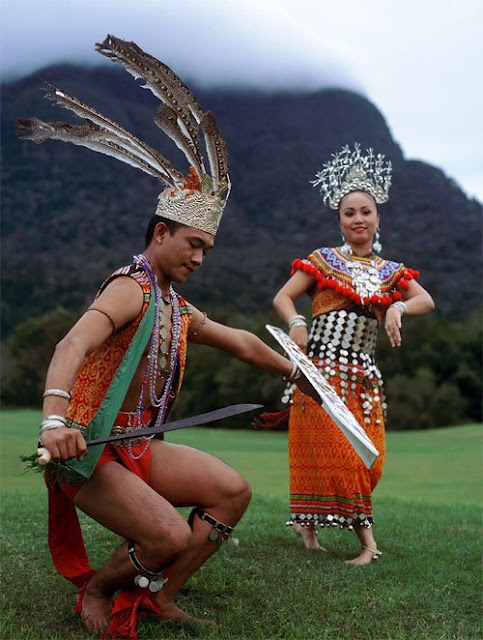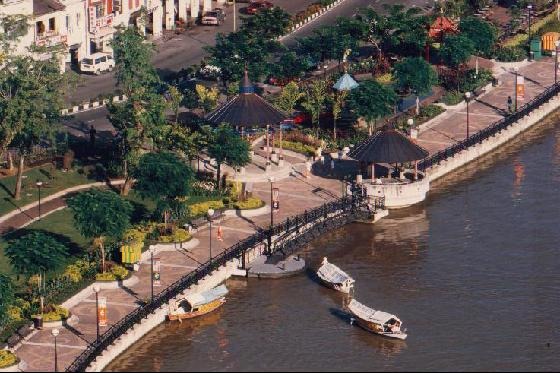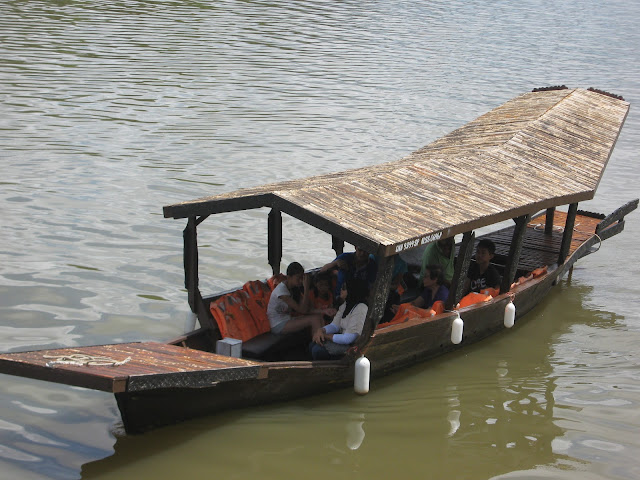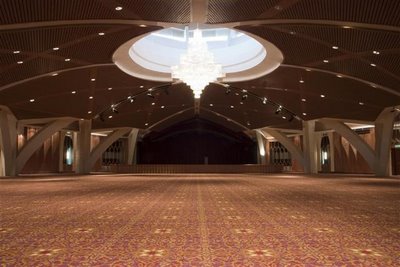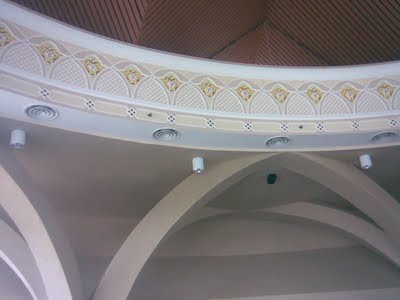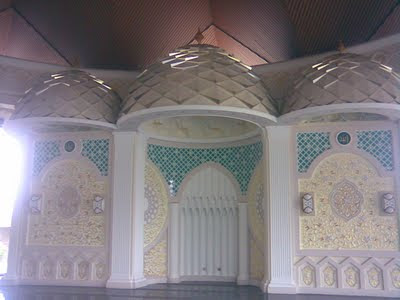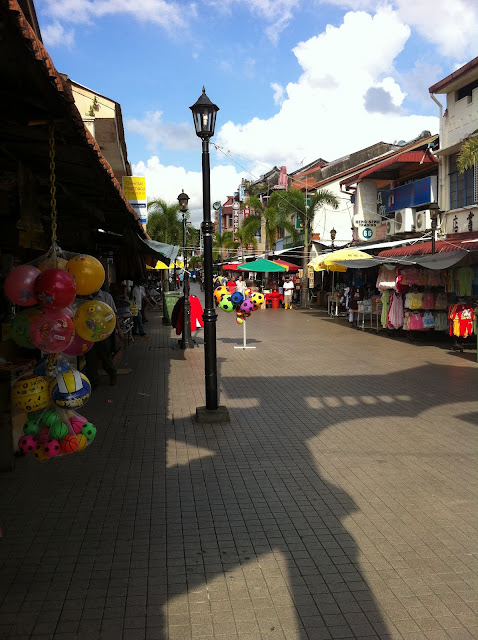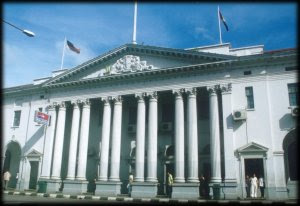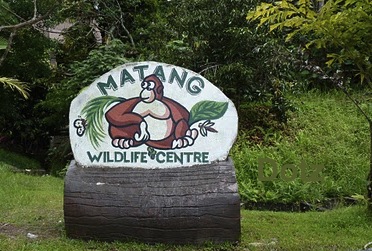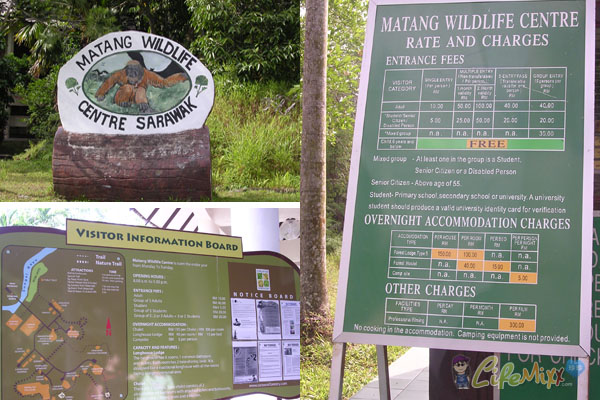Apabila nama Allah dan doa di atas dibisikkan ke telinga kambing yang hendak disembelih, kambing menjadi tenang dan redha untuk disembelih kerana Allah.
Friday 25 May 2012
Saturday 19 May 2012
SARAWAK TRADITIONAL HEADGEARS
Sarawak's ethnic tribes contributed to a colorful spectrum of unique culture in our handicraft heritage. Sarawak’s authentic handicraft is definitely a bonus that will value-add to your visit to this land of the hornbills. Here are a preview into some of the must-see Sarawak handicrafts which will help you identify their heritage roots while you are travelling in Sarawak.
TERENDAK : Headgear from the Melanau Community
Skillfully woven with sago palm strips, wild sago leaves, and rattan strips mostly by the women folks of the Melanau community, this ornate conical-shaped sun hat offers more than just protection from the sun. The intricate design of the Terendak denotes creativity and adds a delightful sense of fashion in the overall costume of the Melanaus.
Where to get:
Hashimah Bt. Narawi, 199, Kg. Baru Ismail, Ingan, 96000 Sibu, Sarawak.
Tel: +6084 832530
TUKUO OR SIPIAH : Headgear from the Bidayuh Community
This spectacular tall cylindrical Bidayuh headgear consists of a piece of red cloth over a tall cylindrical hat intricately woven with bamboo strips. In some areas of Sarawak, Tukuo is often stringed with red, white, black and yellow beads.
SUGU TINGGI FOR IBAN MAIDEN : Headgear from the Iban Community
Sugu Tinggi, is a traditional headgear that is worn by Iban maidens in most ceremonial occasion. It is a silver headgear that gives Iban maidens the unique poise and glitter while dancing the Ngajat Indu. Made mostly by Chinese silversmith, Sugu Tinggi is hand crafted with intricate motifs that depict flowers and other floral themes.
SETAPU TUNJANG FOR THE IBAN WARRIOR : Headgear from the Iban Community
Setapu Tunjang is hand woven using fine bamboo splits and is sometimes decorated with a silver crown. This intricate woven hat is elaborately attached with feathers of hornbills and other wild birds.
Relevant entry :
-> THE IBAN.....the legendary warriors of Borneo; the most feared of the headhunting tribes
KETAPU SILUNG : Headgear from the Orang Ulu Community
The Orang Ulu of Sarawak are famous for their intricate beadwork depicting themes from the rainforest. Their headgears are also skillfully woven with beadwork and bunches of goat’s hair as decoration. The use of hornbill feathers on the headgear denotes authority and status and in some longhouses, hornbill feathers are only allowed to be used on the Ketapu Silung of the master warriors.
Relevant entries :
-> THE KENYAH
-> THE KELABIT.....inhabitants of a remote plateau in the Sarawak Highlands
-> THE LUN BAWANG
KERINGKAM VEIL OF SARAWAK MALAYS
The tudung keringkam of Sarawak is a luxurious small head covering or veil. The veil is skillfully and heavily embroidered with gold thread. It used to be a must-have item for traditional Malay families in Sarawak.
Tudung keringkam was normally worn for weddings, engagements, and other formal ceremonies. In every Malay family the veil became a priceless heirloom, to be passed down from one generation to another.
Today, this traditional head scarf of Sarawak Malays is worn at cultural festivals and on special occasions.
Typically, the tudung keringkam made by the Sarawak Malays is of a deep red color. The keringkam- makers use thin, soft and non-slippery fabric – usually muslin or Swiss voile. They are always done in solid colours. In the old days the selayah was rectangular in shape and the size rather small – usually about two feet by one and a half feet.
The tudungis meant to cover the top of the head with the two ends draping the sides of the head and dangling to just above the shoulders. The newer version of the veil is of bigger rectangles – up to one and a half metres long, the ends reach down to the shoulders. It is also wider.
The square shaped ones are called Selayah.
Tudung keringkam acquired its name from the gold thread called keringkam that is used to embroider the edges and also the sprinkling of small motifs all over the scarf. In the old days the keringkam maker used gold thread from India which they said was of superior quality today, they still prefer this to the newer version imported from Japan.
Tudung keringkam price increases with the increase in price of the gold thread. Now, the price for each tudung keringkam ranges from RM600 to RM 3000. The price is computed according to the amount of gold thread used.
In 1960 the price is RM60 – that was a princely sum then when mid-level civil servants earned between RM250 to RM350 a month.
In days gone by, tudung keringkam played a significant role in Sarawak Malay weddings. According to the old tradition, the bride would send out a mat or 'tikar ngambik pengantin' that had been rolled up and wrapped around with a tudung keringkam to the bridegroom’s house on the wedding day. This was a signal to the groom’s family that the bride’s family was ready to receive the bridegroom and his entourage. Nowadays, with the existence of mobile phones and the internet, such a quaint form of communication is no longer a common practice.
Today, there is a resurgence of interest in tudung keringkam. Anyway, there are only a few skilled keringkam-makers still making the veils in Kuching.
Thus, if the tudung keringkam comes back into fashion, there is no doubt that tudung-keringkam-making may take off as an attractive business venture for younger generation of Sarawak Malays.
NOTE:
The art of embroidering tudung keringkam is now considered a typical Sarawak Malay tradition, but one source suggests it only made its appearance in Sarawak in the 1860s or 1870s, when it was considered the height of imported luxury.
Margaret Brooke, the Second Rajah’s lady, records in her memoirs that she was helped to don traditional dress by some Malay ladies. She wore a red sungkit skirt (kain tape), a blue satin jacket with gold embroidery and gold buttons, ‘...and a gauzy scarf of white and gold, obtained from Mecca, covered my head, and a wide wrap of green silk and gold brocade was flung over the left shoulder ready to cover my head and face when wearing the dress in my walks abroad. According to Datu Isa, my right eye alone should peep forth from the golden wrap on such occasions...’

Saturday 12 May 2012
KUCHING MOST VISITED PLACES
KUCHING..... cats city
James Brooke's arrival and become the first English Rajah of Sarawak, marked the beginning of Kuching as an important administrative centre and consolidated its role as a port. Charles Brooke, his successor in 1868-1917, was responsible for many of the historic buildings.
Sarawak became part of the Federation of Malaysia in 1963, and since then Kuching has changed and developed into a flourishing modern city.
Kuching's name is originated from many sources. Kuching means cat in Malay. Other sources say that Kuching originated from the Chinese word "Gu Chin" which means harbour. Some believe that Kuching is named after fruit called Mata Kuching (Cat's eye).
Kuching has been described in history books as a riverine settlement, a trading post where commercial activities were concentrated along Main Bazaar and Gambier Street areas on the south bank, with the Astana and Malay villages around it on the north bank of Sarawak River.
Kuching, Sarawak's capital, has all the modern amenities without losing its old world charm.
Sarawak River (called Sungai Sarawak by local) separating the north and the south. The bustling streets near the river are packed with ornate temples, markets, historic buildings and traditional Chinese shop houses selling local handicrafts.
Traditional Malay Kampungs (Malay villages) along the Sarawak River with a gorgeous mountainous background can be seen from the Kuching Waterfront. From the middle of the Sarawak River, you can enjoy the view of the 19th century Chinese shop houses, the Malay Mosque, the Square Tower, the attractive Margherita Fort, the Astana and the new Sarawak State Legislative Assembly Building, or DUN (Dewan Undangan Negeri).
KUCHING ATTRACTIONS
Kuching Waterfront
Kuching Waterfront
Kuching Waterfront
The 1 km long Kuching Waterfront was officially opened in 1993. The 890 metres riverside walk linking the hotel precinct with downtown Kuching are rich in local history and culture, packed with facilities for entertainment, refreshment, relaxation, cultural enjoyment and arts appreciation.
The Chinese Museum, the Sarawak Steamship Building, the Godown Amphitheatre, the Round Tower and the Square Tower are amongst the old buildings that have been preserved.
Modern additions to the Waterfront include the Musical Fountains, the Waterfront Square, a restored Chinese Pavilion, an observation tower, a tea terrace and a number of modern sculptures.
Sarawak Water Taxi (Tambang)
Sarawak River Cruise (traditional boat)
At Kuching Waterfront you can take the famous Sarawak Water Taxis (Tambang) to cruise the Sarawak River, which is the best way to get a full view of the Astana (the residence of Rajah Brooke) and Fort Margherita (now a Police Museum), which was built during the Rajah Brooke's time. Cruise by Satok Bridge and get the view of the majestic Sarawak State Legislative Assembly Building or DUN (Dewan Undangan Negeri), cruise by Malay villages and up to the Sarawak Bureau Convention Center (BCC).
Or you can ride the Sarawak River Cruise boats. The Sarawak River Cruises depart daily at about 5.30pm and costs RM60 (US$20) for adults while children pay half price. Some tour agents from the Main Bazaar sell these tickets as well or you can inquire directly from the jetty at Waterfront where the cruise departs.
Kuching Waterfront has won many award since it opened, some of the awards are :
1994 - National Project Award in the Civic Design Category
(Awarded by the Australian Institute of Landscape Architecture)
1994 - Merit Award in the Overseas Category
(Awarded by the Royal Australian Institute of Architecture)
1994 - Excellence on the Waterfront/ Waterfront Centre Annual Award
(Awarded by the Waterfront Centre, USA)
The State Mosque (Masjid Jamek, Petra Jaya, Kuching)
The new Sarawak State Mosque is situated in Petra Jaya, north from the city centre. Also known as Masjid Jamek, it's opening was officiated by Yang Dipertua Negeri Sarawak, Tun Ahmad Zaidi Adruce Mohammad Noor on the 5th October 1990 (16 Rabiulawal 1411 Hijrah) adjacent the state library.
Note: Visitors to mosques are requested to dress respectfully and remove their shoes. Non-Muslims may not enter during prayer times.
Pembukaan Masjid Jamek Negeri Sarawak yang terletak di Petra Jaya, Kuching telah dirasmikan oleh Yang Dipertua Negeri Sarawak, Tun Ahmad Zaidi Adruce Mohammad Noor pada 16 Rabiulawal 1411 Hijrah bersamaan 5 Oktober 1990.
Bentuk Masjid Jamek Negeri Sarawak yang seakan-akan struktur bintang melambangkan pancaran Islam ke seluruh negeri Sarawak dan sebuah menaranya yang setinggi 99 meter melambangkan 99 nama Allah SWT. Masjid ini terletak di Petra Jaya, Kuching ini berkeupayaan memuatkan jemaah sehingga 14,000 orang.
Kuching Mosque
One of the city's most striking landmarks, its majestic silhouette catches the eye and can be seen for miles around. This mosque was completed in 1968, on the site of an old wooden mosque built in 1852. Its splendid gilded cupolas can be seen majestically above the Kuching skyline.
Until the new mosque was built in Petra Jaya, the Kuching Mosque was also the official Sarawak State Mosque.
Please note that visitors to all mosques must dress respectfully and non-Muslims may not enter during prayer times.
From the mosque, retrace your steps towards the riverside to reach Jalan Gambier, which is noted for its Indian spice shops, herbal medicine stores and Chinese groceries.
The Astana
The Astana (the Palace) which lies accross the river, was built in 1870 by the second Rajah, Charles Brooke, as a bridal gift for his wife, the Ranee Margaret. Then known as the Government House. The Palace is actually three separate buildings fused into one. Each connected to the other by short and narrow passageways. First occupied by Charles Brooke in 1870, it was the private residence of the second Rajah. It has undergone substantial alterations and renovations and is today the official residence of the Yang di-Pertua Negeri, the Governor of Sarawak.
Sarawak State Legislative Assembly Building or DUN (Dewan Undangan Negeri Sarawak)
The new Sarawak State Legislative Assembly Building ( Dewan Undangan Negeri Sarawak or DUN) is the current state legislative complex of Sarawak, located at the north bank of the Sarawak River in between The Astana, which is the official residence of the Yang di-Pertua Negeri (Governor) of Sarawak and Fort Margherita.
It is the meeting place for state assemblymen from all over Sarawak to preside over debates and passing of laws. The complex was officially opened by the Yang di-Pertuan Agong (King) of Malaysia, Tuanku Mizan Zainal Abidin on 27 July 2009.
This nine-storey high building is the venue for future Sarawak's new state legislative assembly sittings.The distinctive "payung" (umbrella) roof of the new DUN complex is an iconic landmark for Sarawak.

The architecture of the new complex combines unique elements of Sarawak's heritage with state-of-the-art intelligent building automation systems, multimedia communication facilities, and environmentally friendly features. The new complex development covers and area measuring 172 acres (0.70 km2) near The Astana (Governor's Residence) on the banks of Sarawak River in Petra Jaya, Kuching.
The new chamber can hold up to 108 members, each with their own office. It also has 142 seats for civil servants, 86 in the VIP gallery and 106 in the public gallery. Its architecture and design have meticulously taken into account the future needs of elected representatives.
The building is fully equipped with high-tech information and communication technology. This new DUN complex, perched on the promontory on the pristine bank of the Sarawak River and nestled between the Astana and Fort Margherita, has been described as one of the most beautiful buildings in Southeast Asia.
It is also a depiction of the state’s struggles and achievements over the years after gaining independence through the formation of Malaysia and as a multi-racial society. Reinforced by nine gigantic pillars and numerous arches, the building reflects the sovereignty of the people’s power as well as the support of all the races in the state.
The State Mosque (Masjid Jamek, Petra Jaya, Kuching)
Note: Visitors to mosques are requested to dress respectfully and remove their shoes. Non-Muslims may not enter during prayer times.
Bentuk Masjid Jamek Negeri Sarawak yang seakan-akan struktur bintang melambangkan pancaran Islam ke seluruh negeri Sarawak dan sebuah menaranya yang setinggi 99 meter melambangkan 99 nama Allah SWT. Masjid ini terletak di Petra Jaya, Kuching ini berkeupayaan memuatkan jemaah sehingga 14,000 orang.
Kuching Mosque
One of the city's most striking landmarks, its majestic silhouette catches the eye and can be seen for miles around. This mosque was completed in 1968, on the site of an old wooden mosque built in 1852. Its splendid gilded cupolas can be seen majestically above the Kuching skyline.
Until the new mosque was built in Petra Jaya, the Kuching Mosque was also the official Sarawak State Mosque.
Please note that visitors to all mosques must dress respectfully and non-Muslims may not enter during prayer times.
From the mosque, retrace your steps towards the riverside to reach Jalan Gambier, which is noted for its Indian spice shops, herbal medicine stores and Chinese groceries.
The Astana
The Astana (the Palace) which lies accross the river, was built in 1870 by the second Rajah, Charles Brooke, as a bridal gift for his wife, the Ranee Margaret. Then known as the Government House. The Palace is actually three separate buildings fused into one. Each connected to the other by short and narrow passageways. First occupied by Charles Brooke in 1870, it was the private residence of the second Rajah. It has undergone substantial alterations and renovations and is today the official residence of the Yang di-Pertua Negeri, the Governor of Sarawak.
Sarawak State Legislative Assembly Building or DUN (Dewan Undangan Negeri Sarawak)
The new Sarawak State Legislative Assembly Building ( Dewan Undangan Negeri Sarawak or DUN) is the current state legislative complex of Sarawak, located at the north bank of the Sarawak River in between The Astana, which is the official residence of the Yang di-Pertua Negeri (Governor) of Sarawak and Fort Margherita.
It is the meeting place for state assemblymen from all over Sarawak to preside over debates and passing of laws. The complex was officially opened by the Yang di-Pertuan Agong (King) of Malaysia, Tuanku Mizan Zainal Abidin on 27 July 2009.
Kuching Authority float during the DUN (Sarawak State Legislative Assembly) complex opening
Fireworks during the DUN (Sarawak State Legislative Assembly) complex opening
Fireworks during the DUN (Sarawak State Legislative Assembly) complex opening
This nine-storey high building is the venue for future Sarawak's new state legislative assembly sittings.The distinctive "payung" (umbrella) roof of the new DUN complex is an iconic landmark for Sarawak.

The architecture of the new complex combines unique elements of Sarawak's heritage with state-of-the-art intelligent building automation systems, multimedia communication facilities, and environmentally friendly features. The new complex development covers and area measuring 172 acres (0.70 km2) near The Astana (Governor's Residence) on the banks of Sarawak River in Petra Jaya, Kuching.
The new chamber can hold up to 108 members, each with their own office. It also has 142 seats for civil servants, 86 in the VIP gallery and 106 in the public gallery. Its architecture and design have meticulously taken into account the future needs of elected representatives.
DUN (Sarawak State Legislative Assembly) complex Chamber
The building is fully equipped with high-tech information and communication technology. This new DUN complex, perched on the promontory on the pristine bank of the Sarawak River and nestled between the Astana and Fort Margherita, has been described as one of the most beautiful buildings in Southeast Asia.
DUN (Sarawak State Legislative Assembly) complex Atrium
It is also a depiction of the state’s struggles and achievements over the years after gaining independence through the formation of Malaysia and as a multi-racial society. Reinforced by nine gigantic pillars and numerous arches, the building reflects the sovereignty of the people’s power as well as the support of all the races in the state.
The Surau (the mosque), an annex building of the Sarawak DUN Complex
The Sarawak DUN Complex Surau Ceiling architectural designs
The Sarawak DUN Complex Surau Ceiling
The Sarawak DUN Complex Surau wall designs
The best view of the complex is from the Kuching Waterfront.
Main Bazaar
This row of 2 storey shophouses is located on one of Kuching's oldest streets dating back to 1864. Nowadays it can be considered as an 'antique arcade' not only because of its old-fashioned facade but also for the variety of antiques and handicrafts to be found here. Souvenir-hunters can seek out an assortment of traditional brassware, pottery, ceramics, tribal arts and much much more.
Main Bazaar, like Kuching Waterfront is the most visited place in Kuching as it is the number one place to shop for souvenirs. You can find almost every ethnic handicraft at the shops here. Most Art galleries and craft shops accept credit cards but small vendors accept cash. For large items, most places offer shipping services back to your country for a fee.
The best time to explore this place would be from 10am till 6pm as they start to close by about 6pm.
Kuching Main Bazaar is a place to enjoy the beautiful views of the Sarawak River or simply dine at one of the restaurants or cafes along this place.
Many travel agents who specialize in Eco-Tourism trips, Adventure tours and the Longhouse Visits are found in this street which is dominated by the two storey old pre-war colonial buildings.
India Street Mall
A historical place to shop in Kuching
Along India Street, which is designated as a pedestrian walkway, are a variety of shophouses trading colourful t extiles, clothing, crockery and other essentials in a manner which has not changed much in the past decades.
Tips
Bargaining is very much a way of life here.
Storekeepers are friendly and customers are encouraged to browse around the shops. If you like, you can take a short break here, resting on the attractive wooden benches along the street, just observing life passing by. After this you can proceed down the charming street to find your way to a well-hidden mosque.

The Market was started in 1980 by the Kuching Municipal Council to allow unlicensed hawkers to sell numerous consumable items like fish, meat, clothing, flowers and jungle produces of various kinds. The The bustling Sunday Market with its colourful cornucopia of things has become so popular over the years. The Sunday Market is one of the best place to hunt for souvenirs, handicrafts, local snacks, traditional delicacies and exotic jungle produce in various forms.
Sarawak Steamship Building
Built in 1930, this was previously the office and warehouse of the Sarawak Steamship Company. Extensively restored, its now houses a restaurant, a fast food outlet and a convenience store.
Square Tower
Built in 1879 as a prison, the Square Tower was later converted into a fortress and then a dance hall. From the top of the tower you can view the same spectacular vistas of Mounts Santubong and Serapi that enchanted such illustrious visitors as Somerset Maugham.
Today the Square Tower has been converted into a multimedia information center and video theatre providing information on Sarawak's tourist attractions.
General Post Office
This 1931 building stands out majestically with its imposing neo-classical style and impressive Corinthian columns. In contrast to its ornate facade with semi-circular arches, ornamental columns capitals and friezes, the back of the building is plain and unadorned. Deep parapet walls of plain design hide the pitched root. A colonnaded portico serves as a corridor in front of the building. This will soon be converted into the Sarawak Art Museum.
The Musical Fountain at Kuching Waterfront
The Musical Fountain located at Kuching Waterfront is the most colourful fountain in the city. The colorful Musical Fountain dance according to the rhythm of the classical music.
The square tower is surrounded by 6 rectangular fountain pools.
There are hawkers selling plastic toys that come with a tiny colorful light. This colorful toy can be shot into the sky and drops slowly. This toys attracts not only the locals, but the foreign visitors. Whenever the toys are about to be released together into the dark sky near the fountain, the shooters as well as the hawkers and the spectators will shout "1,2,3!"
Round Tower
Constructed in 1886, the reason for the building of the Round Tower remains a mystery. Because of its structure, it is claimed the building was meant to serve as a fort in an emergency. Instead it became the Dispensary and was then used by the Labour Department until 1980. It now houses a section of the Judicary department. In earlier days, the Round Tower was strategically located to provide an excellent view of the town.
The Textile Museum (the Pavillion)
Next to the Round Tower, behind the Old Court, is The Pavilion, which was built in 1909. Regarded as something of an architectural enigma, its design is reminiscent of buildings in the southern states of America - a mixture of late English renaissancce and colonial architecture. It is rectangular in design, three stories high with a flat concrete roof.
Constructed in 1907 as a medical centre and served as a General Hospital until 1947. Later became the headquarters of the Education Department.
It is currently turned into a textile museum and was open to the public in August 2005. Two flights of timber staircase lead to the upper floors and are decorated with ornamental balustrades. It houses and display authentic local textiles and costumes made by the ethnic community of Sarawak. Examples are the internationally known Iban pua kumbu and Sarawak Malay kain songket.
The exibition flow follows the process of making a textile which starts with the raw material and through the weaving stage and ends up with the finished product. Visitors will have the opportunity to test their skills on the loom and ''touch on' exhibits.
Opening Hours :
Monday to Sunday
9.00 a.m. to 4.30 p.m
Admission is free
The Old Court House
The old Court House was built in 1874. It was the scene of many historic events. The old House was the venue for all state ceremonies. State council (the Dewan Undangan Negeri) meetings were held here from the fifth council meeting in 1878 until 1973. Befitting its status, this is an impressive building with belian (iron wood) roof and is decorated with beautiful engravings reflecting local art form.
The Clock Tower still stand elegantly at the entrance of the old Court House (the clock is still working)
The design of the old Court House complex is colonial and the spacious verandah, supported with strong pillars is ideal for the hot tropics.
This complex now is home to Sarawak Tourism Board. However, there is a small section of the complex which had been converted to Sabati's Women's Museum
Brooke Memorial
The Brooke Memorial located at the front of the Court House is a 6 metre high granite obelisk, which was commissioned in 1924 to honour the 2nd Rajah, Charles Brooke.
At the corner of the obelisk is a bronze panel of four figures representing warriors and leaders from different ethnic groups in Sarawak : Malay, Iban, Dayak and Melanau. The colonial baroque Clock Tower behind the memorial was added in 1883.
Tua Pek Kong Temple
Fort Margherita (Police Museum)
Fort Margherita was built in 1879, in the defensive edifice/castle style of the late English renaissance. The strategic location along the Sarawak River was chosen to overlook the long stretch of river approaching Kuching. It was named after Ranee Margaret, the second Rajah's wife, Charles Brooke.
Fort Margherita has been converted into a Police Museum. Some of its old cannons, cannon balls, guns, pistols, swords and other vestiges of its artillery can still be seen. The armoury still exists as does the condemned prisoner's cell. The Police Museum has a display of old police weapons, reconstructed opium dens and scenes of hanging and other forms of criminal punishment.
Fort Margherita has been converted into a Police Museum. Some of its old cannons, cannon balls, guns, pistols, swords and other vestiges of its artillery can still be seen. The armoury still exists as does the condemned prisoner's cell. The Police Museum has a display of old police weapons, reconstructed opium dens and scenes of hanging and other forms of criminal punishment.
The Police Museum also traces the development of the police force in Sarawak and has an exhibition of weapons used during the Communist Insurgency. It also houses the famous "laughing skulls," which many witnesses claim have the ability to emit an eerie laughing noise.
Sarawak Pottery
Sarawak pottery is famous for its Dayak and traditional designs decorated earthenware vases, of all shapes and sizes. The pottery shop are popular as a regular souvenir-hunting place for local and foreign tourists to remind them of their delightful stay in Kuching.
Sarawak Museum
The Sarawak Museum is acknowledge as one of the finest museum in Southeast Asia. The old Wing, designed in the style of a Normandy town house. Collections include superb ethnographic material, arts and crafts, natural history, and exhibitions of Sarawak's history and prehistory (including a reconstruction of the archaeological finds at Niah Caves) and of the oil industry in Sarawak. Within the grounds are an Aquarium, Botanical Gardens and Heroes' Memorial.
Cat Museum
Dedicated to cats, touted to be the world's first Cat Museum. The Cat Museum houses a collection of all kinds of the adorable feline memorabilia. It displays detailing the evolution and natural history of the cat family, and the development of the different breeds of domestic cat. The Cat Museum is housed in Kuching North City Hall, across the river in Petra Jaya.
Sinar Serapi Eco Theme Park
Sinar Serapi Eco Theme Park Resort and its Home Residence has been operational and opened to the public since October 2010. It is situated at a scenic and unique natural backdrop and setting of the famous Serapi Mountain (Gunung Serapi) approximately 14 km from the city of Kuching in the state of Sarawak, is a concept hatched from a vision of an “utopian ambience” and integrated holiday resort homes.
Coupled with a 20-acre man-made lake brings forth the five natural elements of the universe (commonly known as Fengshui), this holistically integrated development caters an “all-in-one” concept for residential holiday resort homes or home residence, theme park, commercial and recreational activities, and events entertainment which would include a variety of activities and entertainment such as world class concerts, festivals, carnivals, flea markets, children’s and adult’s water-world, and the list goes on.
The theme park resort also features “nature and native” ambience and environment, echoing the astounding natural qualities of beautiful Sarawak. This unique concept of a theme park resort and home residence has also won the Sarawak Housing & Estate Development Association SHEDA Excellence Award 2009 (Special Award for Best Design Concept) which was presented to Mr. Ambrose Wong in January 2010.
Its home residence facilities and packages are catered as home-stay concept with available theme park facilities also included. These are all fully furnished houses, with 4 bedrooms and 3 bathrooms, and each unit rented overnight comes with complimentary breakfast for 7 persons and free access to water facilities.This home-stay concept manages to cater not only for corporate team building events, but also for family bonding and getaways for both local and foreign tourists.
An award-winning attraction, Sarawak Cultural Village showcases the diverse lifestyles of the state's ethnic groups. Visit the authentic dwellings and view their crafts, household items and musical instruments. The lively cultural performance is a major highlight here.
Matang Wildlife Centre
Provides the opportunity to view animals in enclosures.
Bako National Park
Sarawak has many national parks, each teeming with a wealth of flora and fauna. Bako National Park is the state's oldest, and home to the rare long-nosed proboscis monkeys, long-tailed macaques and various other animals. It serves as an excellent introduction to the rainforest.
Kubah National Park
The world's largest collection of palm trees, rare ferns and wild orchids are the main attractions here. The enclave is further enriched with waterfalls and crystal-clear rivers.
Damai Beach Resort
Damai Beach is one of the state's best beach resorts with a wide range of water sports activities. Tours can be arranged to see the rare irrawaddy dolphin.
Damai Central
Damai Central is a new tourist attraction located at Pantai Damai, Santubong, Kuching.
The Damai Central complex features an open design concept which takes full advantage of the natural ambiance of sun sand and sea, with a backdrop of jungle greenery and mountain landscape. Situated on a 3.5 hectare land, it snuggles between the internationally known Damai Beach Resort and Damai Puri Resort & Spa, and opposite Sarawak’s tourism icon, Sarawak Culture Village.
The complex consists of a food court featuring local specialities and commercial lots made up of a seafood restaurant and a bar facing the open sea, convenience shop, souvenir outlets as well as booths for tours arrangement, renting of recreational facilities and services
Besides the business lots, there is a multi-purpose hall, an open-stage and an open-air arena, which are ideal for staging concerts, carnivals and exhibitions. The views and the combination of ‘five elements’ (sun, sand, sea, jungle, mountain) drives Damai Central to be one of the most innovative resort-style complex in Sarawak.
Siar Beach Resort
Siar Beach Resort occupies a secluded, peaceful and tranquil beach front. Only an hour drive from Kuching City.
Relax, stroll on the white sand or have a relaxing swim in the sea. Visit Lundu Township with its friendly locals or stop by the fish market for catches for your BBQ. If you are lucky, the world's largest flower "The Rafflesia" could be in full bloom at Gunung Gading National Park on your way to Siar Beach Resort. Specious, well appointed bungalows offering a unique, luxurious retreat, perfect for couples, groups or family day activities, or church retreat. Just a few steps away from the beach front.
Sematan Beach
Before Damai Beach was developed, Lundu and Sematan were the only two places in Kuching where you could find accessible beaches.
Sematan Beach is 20 km from Lundu Town. Driving time is around 20 mins, the road is very good.
Sematan jeti
Sematan Malay Village
Gunung Gading National Park

Gunung Gading National Park is one of the best places in Asia to view the Rafflesia’s spectacular blooms. Gunung Gading sprawls across four jungle-clad mountain peaks, and its dense primary rainforest is criss-crossed by crystal clear streams and waterfalls.

Gunung Gading was gazetted as a park in 1st August 1983 primarily to provide a conservation zone for the protection of the Rafflesia. It was opened to the public in 1994. The park is easily accessible from Kuching on a day trip. Those wishing to stay longer can enjoy Gunung Gading’s other attractions - particularly its rainforest scenery, waterfalls and jungle trails. Some of these trails lead to the peaks of the mountains that make up the park and offer challenging jungle treks.
Tanjung Datu National Park
Tanjung Datu, just under 14 sq km, is the smallest of Sarawak’s National Parks. The park, one of the most beautiful, comprises a narrow ridge of rugged forest-covered hills fringed by pristine white sand beaches, crystal clear waters and patches of coral reef.
The rich mixed dipterocarp forest reaches almost to the water’s edge in some places, and this close proximity of rainforest and coral reef - the two most diverse natural communities on our planet - make Tanjung Datu a very important reservoir of biodiversity.
Located at the south-western tip of Sarawak on the Datu Peninsula, Tanjung Datu is one of Sarawak’s less accessible natural parks, but its relative remoteness is one of its main attractions. The beaches really are undisturbed, the corals offshore are untouched and the forest trails are virtually untrodden. This seclusion has helped to preserve a wide range of unusual plant species, including the night-blooming Putat tree (barringtonia asiatica), which produces pink and white flowers the size of tennis balls, huge Umbrella Palms and Strangling Figs, whilst the beaches are fringed with purple-flowered Sea Morning Glory.
Tanjung Datu’s animal life is equally rich and varied. Notable amongst the hundreds of bird species are at least three types of Hornbill, as well as peacocks. Primates include Bornean Gibbons, Pig-Tailed Macaques, Long-Tailed (or Crab-Eating) Macaques, and Silvered and Banded Langurs (or Leaf Monkeys). Bearded Pigs, Sambar Deer, Mouse Deer, Barking Deer, Bearcats, Civet Cats and various species of squirrel are amongst the land mammals that may occasionally be seen here.
Reptile species include a variety of ground and tree lizards, as well as Pit Vipers and Tree Snakes, but Tanjung Datu’s greatest contribution to reptile conservation is its role as a marine turtle nesting site. Highly endangered Green Turtles and Olive Ridley Turtles regularly lay their eggs on the park’s beaches. Therefore a turtle hatchery has been established - a fenced-off area close to the beach which is protected and monitored by park staff. Eggs from nests vulnerable to predators such as pigs, monitor lizards and snakes are relocated here to reduce the high levels of natural mortality. As well as turtles, the waters offshore from Tanjung Datu are home to dolphins, and unidentified whale species have also been reported.
The unpolluted crystal clear waters of the South China Sea support a wide range of marine life, and the coral grows close inshore. This makes Tanjung Datu a good location for snorkeling and scuba diving, although scuba divers have yet to explore its full potential.
The 24 sq km Batang Ai National Park is part of the region’s largest trans-national protected area for tropical rainforest conservation. The park adjoins the Lanjak-Entimau Wildlife Sanctuary in Malaysia and the Bentuang-Karimun National Park in Indonesia. Together these totally protected areas cover almost 10,000 sq km and form a sanctuary for one of the few viable orang utan populations in Borneo (estimated at over 1,000 animals) as well as many other endangered species. For conservation reasons, Batang Ai National Park is the only part of this area open to visitors, but as it has the highest orang utan population density in central Borneo (up to 1.7 animals per sq km), there is a good possibility of seeing wild orang utan. However orang utan sightings should be regarded as a bonus not as a guaranteed experience.
Relevant entries :
-> KUCHING WATERFRONT HISTORY AND ATTRACTIONS
-> KUCHING WATER TAXI.....GONDOLA OF THE EAST
-> SARAWAK RIVER CRUISE.....THE BEST WAY TO EXPERIENCE SARAWAK RIVER
-> SINAR SERAPI ECO THEME PARK
-> SARAWAK THE LAND OF THE HORNBILLS
-> SEMENGGOH WILDLIFE REHABILATION CENTRE
-> BAKO NATIONAL PARK
-> JONG'S CROCODILE FARM & ZOO
-> ANNAH RAIS LONGHOUSE
-> FAREWELL TO SUNDAY MARKET AT SATOK
-> Plans set to get Siniawan town heritage status
-> The vintage town of Siniawan
-> Pasar Serikin
-> SIR JAMES BROOKE,The Rajah of Sarawak
-> REPORT ON JAMES BROOKE’S COTTAGE ON BUKIT SERUMBU, SINIAWAN, BAU.
-> Restoration of Brooke Cottage, Wallace Trail to start in June
Subscribe to:
Posts (Atom)






